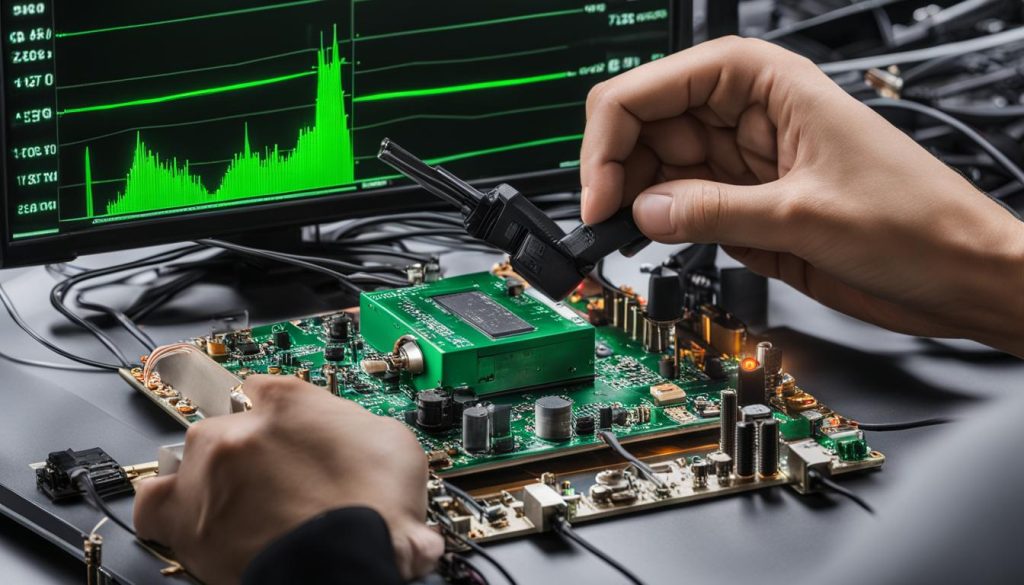Welcome to our in-depth guide on 2.4GHz technology in RC (radio control). If you’re curious about why 2.4GHz is the go-to frequency range for remote control enthusiasts, you’ve come to the right place. In this section, we’ll delve into the benefits, advantages, and compatibility of 2.4GHz RC technology.
Key Takeaways:
- 2.4GHz offers a reliable and interference-resistant radio control frequency for RC applications.
- With higher RF power output, the shorter wavelength of 2.4GHz can overcome its weaker signal penetrating power compared to older frequencies.
- Compatibility between the transmitter and receiver depends on matching the modulation protocols.
- Using the same branded receiver as the transmitter ensures optimal reliability.
- 2.4GHz allows for a wide range of available frequencies, providing incredible reliability for RC operation.
An Introduction to the Types of Transmitters
When it comes to RC car control, the transmitter you choose plays a crucial role in your overall experience. There are two common types of RC transmitters: the Pistol Grip Transmitter and the Stick Transmitter. Let’s take a closer look at each one and their unique features.
Pistol Grip Transmitter
The Pistol Grip Transmitter, shaped like a gun, is the most popular choice among RC enthusiasts. Its ergonomic design provides a comfortable grip, allowing for precise control over your RC car. This type of transmitter features a trigger that controls the speed and a wheel for steering. With the ability to modulate throttle and adjust speed on the go, the Pistol Grip Transmitter offers an intuitive and responsive control mechanism.
Stick Transmitter
The Stick Transmitter, also known as a “joystick” transmitter, uses two sticks to control various functions of your RC car. Unlike the Pistol Grip Transmitter, the Stick Transmitter offers separate control over speed, braking, and steering with the use of joysticks. The left joystick typically controls the steering, while the right joystick controls the speed and braking. This type of transmitter provides a more traditional and familiar control mechanism.
When it comes to choosing between these two types of transmitters, it ultimately comes down to personal preference. Some RC enthusiasts prefer the ergonomic design and intuitive control of the Pistol Grip Transmitter, while others appreciate the familiarity and flexibility of the Stick Transmitter. Consider your own comfort and control preferences to make the best choice for your RC car adventures.
Channel Setups and Functions
When it comes to RC cars, understanding the channel setups and functions is crucial for optimizing your control and performance. Most RC cars utilize a 2-channel setup, where one channel is dedicated to steering and the other channel controls speed and braking.
The steering channel allows you to control the direction of your RC car. By manipulating the steering channel, you can navigate your vehicle smoothly around corners and obstacles, giving you precise control over its movements.
The speed and braking channel is responsible for controlling the acceleration and deceleration of your RC car. This channel enables you to adjust the speed of your vehicle, allowing you to achieve the desired level of power and control during your RC adventures.
However, advanced RC cars may require additional channels to unlock advanced functions and capabilities. These additional channels can be used for features such as differential locking, which enhances traction on uneven terrains, and gear shifting, which provides different speed ranges for varied driving conditions.
Additionally, some high-end RC cars may utilize a gyro control channel. A gyro control helps stabilize the vehicle by minimizing unwanted wheel spin and providing better control and balance, particularly during high-speed maneuvers or off-road adventures.
When selecting a transmitter for your RC car, it is essential to consider the specific channel requirements of your vehicle. Ensure that the transmitter you choose has the necessary channels to accommodate the functions and capabilities of your RC car, allowing you to fully unleash its potential.
Understanding the 2.4GHz Transmission
The 2.4GHz transmission system is the lifeblood of RC car communication, providing seamless contact between the transmitter and receiver. It offers a reliable and interference-resistant connection, ensuring smooth operation and control over your RC car. One of the most impressive features of the 2.4GHz transmission is its exceptional range, allowing you to control your vehicle from a significant distance.
Modern digital radio systems employ advanced technologies such as spread-spectrum and frequency hopping to enhance the reliability and range of the 2.4GHz transmission. Spread-spectrum techniques distribute the RC signal across a wide range of frequencies, reducing the risk of interference from other devices operating on the same frequency band. Frequency hopping further improves interference resistance by quickly switching between different frequencies within the 2.4GHz range.
With the spread-spectrum and frequency hopping technologies, multiple RC vehicles can operate simultaneously without interfering with one another. This is particularly beneficial when racing or operating multiple RC cars in the same area, as each vehicle can maintain its reliable connection and consistent control.
The reliability and interference resistance of the 2.4GHz transmission make it a preferred choice among RC enthusiasts. Whether you’re navigating challenging terrains, performing complex maneuvers, or engaging in thrilling races, the 2.4GHz transmission ensures a stable connection between your transmitter and receiver, providing you with precise control over your RC car.
Now, let’s take a closer look at how to bind a transmitter to a receiver to establish a secure communication link.
Binding a Transmitter to a Receiver
Binding is a crucial process that allows you to pair a transmitter with a receiver in order to establish a secure and unique communication link. This ensures that no other signals interfere with your control over the RC vehicle. To successfully bind the transmitter and receiver, you need to follow a specific process.
The first step is to put the transmitter into bind mode. This can usually be done by accessing the bind mode menu or pressing a specific button combination on the transmitter. Once the transmitter is in bind mode, make sure to power on the receiver.
When the receiver is powered on, it enters a mode where it actively looks for a compatible transmitter to bind with. During this process, the transmitter and receiver exchange information to establish a secure communication link. It is important to note that each transmitter and receiver pair has its own unique binding process, so be sure to follow the instructions provided by the manufacturer for your specific model.
Compatibility is another important factor to consider when binding a transmitter to a receiver. To ensure successful binding, the transmitter and receiver need to be compatible in terms of brand, model, and communication protocols. Using the same brand for both the transmitter and receiver generally guarantees compatibility and reduces the chance of any compatibility issues during the binding process.
Remember, different brands and models may have their own unique binding procedures, so it is essential to carefully read the instruction manual or follow the manufacturer’s guidelines specific to your transmitter and receiver pair.

Key Points:
- Binding is the process of pairing a transmitter with a receiver.
- Put the transmitter into bind mode and power on the receiver.
- Establish a unique communication link between the transmitter and receiver.
- Ensure compatibility between the transmitter and receiver.
- Follow the specific binding instructions provided by the manufacturer.
Transmitter Adjustments for Customization
When it comes to customizing the control of your RC car, transmitter adjustments play a crucial role. These adjustments allow you to fine-tune various settings to personalize your driving experience. From throttle and steering trims to dual rates and end point adjustment (EPA), each adjustment has its own impact on how your RC car handles on the track.
The throttle and steering trims help you adjust the resting rate and direction of your car when no input is given. By making small adjustments to these trims, you can ensure that your car stays straight and maintains the desired idle speed.
The dual rates feature allows you to control the range of motion in the controller’s servos. This adjustment is particularly useful for regulating the sensitivity of your car’s steering and throttle. By adjusting the dual rates, you can modify the speed and response of your car, making it more manageable and easier to control.
Another important adjustment is end point adjustment (EPA), which allows you to set the maximum points of servo movement. This feature enables you to fine-tune the range of motion for both the throttle and steering, ensuring precise control over your RC car’s speed and turning radius.
Exponential rates (EXP) are yet another customization option. This adjustment affects the stick’s sensitivity around its neutral point. By adjusting the exponential rates, you can control the responsiveness of your car when the stick is slightly moved from its center position. This adjustment can be used to fine-tune your car’s acceleration and turning response to match your driving style and track conditions.
Experimenting with these transmitter adjustments is key to finding the perfect setup for your RC car. By making small incremental changes and testing them on the track, you can achieve a personalized driving experience that suits your preferences and maximizes your performance.
With these transmitter adjustments, you have the power to customize your RC car’s control to your liking. Whether you’re fine-tuning the throttle and steering trims, adjusting the dual rates, setting end point adjustment (EPA), or modifying the exponential rates (EXP), each adjustment allows you to tailor your RC car’s performance to match your driving style and track conditions.
Now that you understand the importance of transmitter adjustments for customization, let’s explore the power considerations and advanced features of RC transmitters in the next section.
Power Consideration and Advanced Features
When it comes to powering your RC transmitter, there are a few options to consider. Traditionally, AA batteries have been the go-to power source for transmitters. They are widely available and easy to replace. However, they have some drawbacks, such as limited lifespan and performance. As technology advances, rechargeable battery packs like NiMH (Nickel-Metal Hydride) and LiPo (Lithium Polymer) are gaining popularity among RC enthusiasts.
Rechargeable packs offer several advantages over AA batteries. They provide consistent performance throughout their charge cycle, ensuring that your transmitter operates at its best. Additionally, they are environmentally friendly, as they can be recharged and reused multiple times, reducing waste and saving money in the long run. The choice between NiMH and LiPo depends on your specific needs and preferences. NiMH batteries are known for their reliable performance and lower cost, while LiPo batteries offer higher energy density and lighter weight.
When using rechargeable packs, it’s important to ensure that the battery voltage matches the requirement of your transmitter. Using an incompatible voltage can lead to damage and affect the performance of your system. Always refer to the manufacturer’s specifications and guidelines for the recommended battery voltage.
Advanced features on transmitters can significantly enhance the RC experience. These features vary by model and brand, offering a range of exciting options for customization. Some common advanced features include:
- Telemetry: Provides real-time data feedback from your RC car, such as speed, temperature, and battery voltage, allowing you to monitor and optimize performance.
- Programmability: Allows you to customize various settings and controls, such as throttle response, steering sensitivity, and servo limits, tailoring the transmitter to your specific preferences and driving style.
- Wireless Connectivity: Enables wireless communication between your transmitter and compatible accessories or devices, offering additional functions and expanding the versatility of your RC system.
- Multiple Model Memory: Allows you to store settings and configurations for multiple RC cars, making it easy to switch between different vehicles without the need for manual adjustments.
- Backlit Display: Enhances visibility, especially in low-light conditions, ensuring that you can easily read and adjust settings on your transmitter.
These advanced features not only provide added convenience but also open up new possibilities for performance optimization and personalization. However, it’s important to remember that the availability of these features may vary depending on the model and brand of your transmitter.
Considering the power source and advanced features of your transmitter is crucial for maximizing your RC experience. Whether you opt for traditional AA batteries or embrace rechargeable packs, be sure to choose a power source that suits your needs and matches the requirements of your transmitter. Additionally, exploring and utilizing advanced features can unlock new levels of customization and performance for your RC car.

Previous: Transmitter Adjustments for Customization | Next: Range and Interference Considerations of 2.4GHz Systems
Range and Interference Considerations of 2.4GHz Systems
When it comes to radio control technology, 2.4GHz systems are highly popular for their interference resistance and reliability. However, it’s important to consider some key factors that might affect the performance of these systems. Let’s explore the range discrepancies, loss of control, and other considerations related to 2.4GHz RC systems.
Compared to older frequency systems like 72 MHz, 75 MHz, and 27 MHz, 2.4GHz systems may experience range discrepancies. While 2.4GHz offers an impressive range, it may not be as far-reaching as some of the traditional frequency bands. It’s crucial to understand that the shorter wavelength and higher frequency of 2.4GHz signals may result in slightly reduced range capabilities, especially in environments with obstacles such as buildings or thick foliage.
Despite the range discrepancies, 2.4GHz systems have significantly minimized the problem of “taking a hit.” In older systems, adjacent frequencies often interfered with each other, causing a loss of control. With 2.4GHz, this issue has been greatly reduced due to the spread-spectrum and frequency hopping technology incorporated into modern digital radio systems. These advanced features enhance interference resistance, allowing multiple RC vehicles to operate simultaneously without interrupting each other’s signals.
“It’s crucial to understand that the shorter wavelength and higher frequency of 2.4GHz signals may result in slightly reduced range capabilities.”
However, it’s important to note that loss of control can still occur in 2.4GHz systems, albeit less frequently. Factors such as temporary interference or equipment malfunctions can potentially disrupt the connection between the transmitter and receiver, leading to a momentary loss of control. While rare, it’s essential to be aware of this possibility and take necessary precautions to prevent any accidents or damage.
In terms of range limitations, it’s worth mentioning that 2.4GHz signals might not penetrate certain materials like leaf cover or water spray as effectively as lower frequency bands. This means that if you’re operating your RC vehicle in dense vegetation or water, you might experience a decrease in range or intermittent signal glitches. Understanding these limitations helps you make informed decisions regarding the choice of radio system and avoid unexpected range issues.
Overall, despite the range discrepancies and potential loss of control, 2.4GHz systems remain highly reliable and offer superior interference resistance compared to older frequency bands. They provide a robust communication channel and ensure a smooth and enjoyable RC experience for most users. It’s important to choose a compatible transmitter and receiver, consider the specific range requirements of your RC activities, and be mindful of any environmental factors that might affect the signal quality.
Considerations for Choosing the Right RC Frequency
When it comes to choosing the right RC frequency, several factors need to be taken into consideration. These include reliability, interference resistance, range, and the specific use cases for your RC system. While 2.4GHz RC systems are popular for their reliability and interference resistance, lower frequency bands like 27 MHz still have their advantages in certain scenarios.
One of the benefits of using lower frequency bands is their ability to penetrate through certain barriers, such as water. For example, 27 MHz frequency is commonly used for running submarines due to its ability to communicate and control the RC underwater. This makes it an ideal choice for enthusiasts who are passionate about underwater RC vehicles.
That being said, it’s important to note that some frequency bands, such as 27 MHz, are considered to be obsolete radio technology. They may not offer the same level of reliability, range, or interference resistance as newer technologies like 2.4GHz. It’s essential to carefully evaluate the benefits and limitations of each frequency band to ensure it aligns with your specific needs and requirements.
Below, you’ll find a comparison table outlining some key considerations for choosing the right RC frequency:
| Frequency Band | Benefits | Limitations |
|---|---|---|
| 2.4GHz | Reliable, interference resistant, wide range of available frequencies | May have range limitations, shorter wavelength |
| 27 MHz | Penetrates water, commonly used for submarine RC vehicles | Obsolete radio technology, limited availability |
| Other Lower Frequency Bands | Potentially longer range, suitable for specific use cases | May have limited frequency availability, susceptible to interference |
Ultimately, the choice of RC frequency depends on your specific needs and preferences. If you prioritize reliability and interference resistance, 2.4GHz RC systems are a solid choice. However, if you have specific use cases that require the ability to penetrate certain barriers like water, lower frequency bands like 27 MHz may be worth considering. The key is to carefully evaluate the pros and cons of each frequency band to make an informed decision for your RC system.
Conclusion
In conclusion, 2.4GHz is the preferred frequency in RC technology for a variety of reasons. It offers exceptional reliability, ensuring seamless communication between the transmitter and receiver. The 2.4GHz band provides superior interference resistance, allowing multiple RC vehicles to operate simultaneously without signal interference.
Furthermore, 2.4GHz systems offer an impressive range, enabling RC enthusiasts to explore larger areas and enjoy uninterrupted control. While there may be some range limitations in specific scenarios, overall, 2.4GHz delivers a superior RC experience for most users.
When choosing the right RC frequency, it is crucial to select a compatible transmitter and receiver to ensure optimal performance. Additionally, making necessary adjustments to customize the control, such as throttle and steering trims, dual rates, and endpoint adjustments, can greatly enhance the driving experience.
Ultimately, consider your specific needs and requirements when selecting an RC frequency. Whether you’re a casual user or a passionate hobbyist, the reliability, interference resistance, and robust communication channels of 2.4GHz systems make them an excellent choice for RC enthusiasts.
FAQ
Why is 2.4GHz used for RC technology?
The 2.4GHz band is used in RC technology because it offers incredible reliability and provides more available frequencies for operation.
What are the benefits of 2.4GHz for RC?
The 2.4GHz frequency range provides reliability, interference resistance, and an impressive range for RC communication. It also allows multiple RC vehicles to operate simultaneously without interference.
What are the two common types of RC transmitters?
The two common types of RC transmitters are Pistol Grip Transmitter and Stick Transmitter. The Pistol Grip Transmitter resembles a gun and features a trigger for speed control and a wheel for steering. The Stick Transmitter uses two joysticks to control speed, braking, and steering.
How many channels are typically used in RC cars?
Most RC cars use a 2-channel setup, where one channel controls steering and the other controls speed and braking. However, advanced RC cars may require additional channels for functions like differential locking, gear shifting, and gyro control.
What is the purpose of binding a transmitter to a receiver in RC?
Binding is the process of pairing a transmitter to a receiver to establish a unique communication link. This ensures that no other signals interfere with the control of the RC car.
What transmitter adjustments can be made for RC customization?
Transmitter adjustments such as throttle and steering trims, dual rates, end point adjustment (EPA), and exponential rates (EXP) allow you to customize the control of your RC car based on your preferences.
What power sources can be used for RC transmitters?
RC transmitters typically use AA batteries, but rechargeable battery packs like NiMH or LiPo are becoming more popular. AA batteries are widely available but have limited lifespan and performance, while rechargeable packs provide consistent performance throughout their charge cycle.
What are the range and interference considerations of 2.4GHz systems?
While 2.4GHz systems offer benefits like interference resistance, there may be range discrepancies compared to older frequency systems. Loss of control can still occur, and range limitations can be a factor due to the signal’s ability to penetrate certain solids like leaf cover or water spray.
How do you choose the right RC frequency?
When choosing the right RC frequency, it is important to consider factors like reliability, interference resistance, range, and specific use cases. While 2.4GHz systems are popular for their reliability and interference resistance, lower frequency bands like 27 MHz still have advantages in certain scenarios.




